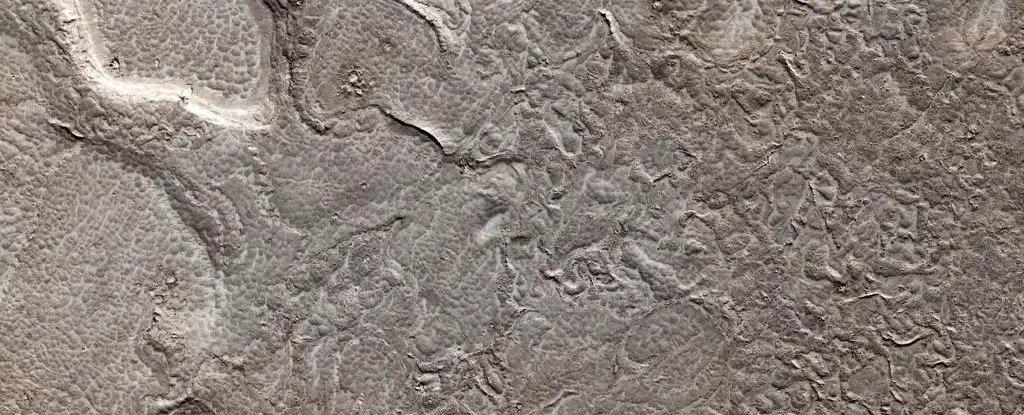The belief of a desolate and sterile Mars has long been debunked with the revelation of new findings. A comprehensive survey employing satellite imagery and ground penetrating radar has disclosed evidence of volcanic activity on Mars that is much more recent than previously theorized. These findings challenge the conventional notion of Mars as a dead planet and suggest that beneath its barren surface, the Red Planet might host a more dynamic and geologically active environment than initially assumed.
The survey conducted on the Elysium Planitia, a plain on Mars, unearthed signs of volcanic activity that occurred within the last 120 million years. Astonishingly, some of the identified volcanic events were dated back as recently as 1 million years ago. Although no direct observation of ongoing volcanic activity has been made, the proximity of these relatively recent events implies the potential for active volcanism on Mars even today. Co-leading the study, planetary scientists Joana Voigt of NASA’s Jet Propulsion Laboratory and Christopher Hamilton of the University of Arizona, highlight the newfound dynamic nature of Elysium Planitia.
The surface of Elysium Planitia presents a striking and captivating landscape for those with an inclination toward geological formations. The presence of remarkably young lava flows has left scientists perplexed. Furthermore, the intricate land features carved out by the interaction of lava with ice or liquid water, leading to steam explosions, add to the intrigue. On Earth, landscapes combining hot geological activity with water, such as hot springs, harbor unexpectedly thriving microbial life, raising the possibility of similar phenomena on Mars. The similarities between these two planets intensify the speculation regarding the emergence of life in such environments.
To shed light on the volcanic history of Elysium Planitia, the researchers meticulously combined data from various sources. They relied on topographic maps to analyze surface shape, satellite imagery to study distinctive features, and ground-penetrating radar to obtain density maps up to 140 meters (460 feet) below the surface. Voigt emphasizes, “Elysium Planitia is the ideal location to comprehend the connection between surface manifestations and the internal dynamics that manifest through volcanic eruptions.” Scrutinizing the details of lava surfaces played a crucial role in disentangling the different eruption events, enabling the team to reconstruct the entire geological history of these intriguing formations.
The survey findings allowed the researchers to map and retrace every individual lava flow within Elysium Planitia in three dimensions. The stunning revelation exposed a landscape composed of material from over 40 volcanic events, ranging from 120 million to 1 million years ago. Some of these eruptions were titanic in scale. For instance, one eruption inundated Rahway Valles with a staggering 16,000 cubic kilometers (3,840 cubic miles) of molten basalt. Similarly, Marte Vallis witnessed 12,200 cubic kilometers, while Athabasca Valles was flooded with 4,000 cubic kilometers of molten rock. Interestingly, despite the apparent aridity of present-day Mars, the vents that facilitated the flow of lava may have concurrently released cataclysmic floods of groundwater, leading to exceptionally explosive events that shaped the Martian landscape. On Earth, the addition of steam to volcanic eruptions results in some of the most dramatic and explosive phenomena. Hamilton explains, “When there is a crack in the Martian crust, water can flow onto the surface. Due to the low atmospheric pressure, the water is likely to evaporate rapidly. However, if a substantial volume of water were to emerge during this period, a colossal flood can ensue, cascading over the landscape and carving out the massive features we now observe.”
Previous studies have already indicated the youthfulness of volcanic features on the surface of Elysium Planitia, with some estimated to be as young as 50,000 years. Furthermore, seismic data collected by the retired Mars InSight lander has provided evidence of significant geological activity, including volcanism, on Mars. The latest discoveries on Elysium Planitia upend traditional assumptions and lend support to the theory that this region is not just critical in understanding Mars’ volcanic history, but also the potential hiding place for water reserves. The research team’s findings imply that substantial water ice deposits might still be concealed underground, even in the present times. In their paper, they assert, “The young volcanic surfaces and the recent detection of seismic activity in Elysium Planitia could imply that Mars is still volcanically active.”
Mars, once presumed to be a frigid and lifeless planet, has gradually revealed its secrets through meticulous scientific exploration. The unveiling of recent volcanic activity on Mars challenges our preconceptions and invites us to reconsider the potential for life beyond Earth. The rich volcanic history of Elysium Planitia, with its colossal eruptions and catastrophic floods, adds to the allure of Mars’ geologically active past and provides tantalizing hints about the possibility of its volcanic present. As our understanding of Mars deepens, so does the prospect of unraveling its mysteries and peering into the realm where ancient and present volcanic forces collide.


Leave a Reply